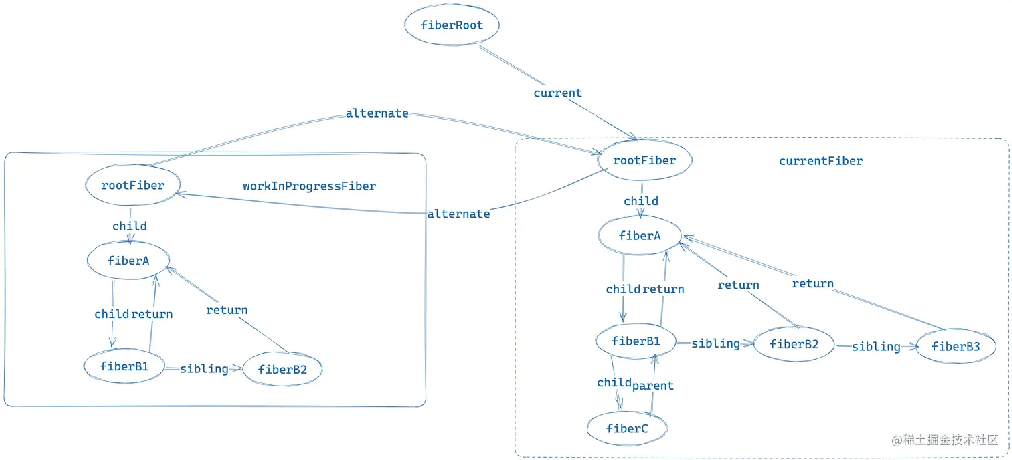目录正文一、React.createElement和ReactElement元素二、双缓存技术三、React初始化的执行函数正文 前面两篇文章介绍了fiber架构和workLoop
前面两篇文章介绍了fiber架构和workLoop如何调度。但是缺了一块非常重要的地方,那就是开发者写的代码是如何对接到上面流程的?
在日常开发中,我们只关心了如何写组件,但是写完的组件是如何被渲染到页面当中?又是如何驱动更新流程?如果不知道这块内容,其实大家还是云里雾里的停留在概念层面。
所以这篇文章主要是从开发者角度阐述开发代码->编译->触发更新流程的介绍。
这里的更新流程指schedule(调度)->reconciler(协调)->commit (渲染)
老规矩还是先制定5个小目标:
ok,我们一一解答:
首先我们书写的函数式组件、类组件、jsx等代码全部会被babel-react编译成react.createElement()的调用或者jsx()调用(取决于react版本)。
举个栗子:
<div>
<ul>
<li key='1'>1</li>
<li key='2'>2</li>
<li key='3'>3</li>
</ul>
</div>
转换成
React.createElement(
'div',
null,
React.createElement(
'ul',
null,
React.createElement(
'li',
{
key: '1'
},
'1'
),
React.createElement(
'li',
{
key: '2'
},
'2'
),
React.createElement(
'li',
{
key: '3'
},
'3'
)
)
);
接下来我们需要知道React.createElement内部到底做了什么?源码位置
内部的实现其实很简单,就是处理传入的type/config/children等参数,再返回一个新的对象。
ReactElement数据结构如下:
const element = {
$$typeof: REACT_ELEMENT_TYPE,
type,
key,
ref,
props,
};
所以上述栗子的调用结果是下面的树形结构:
{
type: 'div',
key: null,
ref: null,
props: {
children: {
type: 'ul',
key: null,
ref: null,
props: {
children: [
{
type: 'li',
key: null,
ref: null,
props: {
children: '1'
}
},
{
type: 'li',
key: null,
ref: null,
props: {
children: '2'
}
},
{
type: 'li',
key: null,
ref: null,
props: {
children: '3'
}
}
]
}
}
}
}
到这里就已经完成第一个和第二个小目标。
不过在这里要多提一下,上述的树形结构,在react15版本及以前就可以直接拿来diff以及生成页面,不过正如第一篇文章所说,这样会遇到很大的问题(任务过重js执行时间久,影响渲染)。
所以16之后做的事情,就是依据上述的树形结构进行重构,重构出来的fiber数据结构用于满足异步渲染之需。
上篇文章中已经介绍了fiber节点的数据结构,这里我们再介绍下fiberRoot以及rootFiber。 fiberRoot源码位置
FiberRoot数据结构:
class FiberRootnode {
current: FiberNode;
container: any | null;
finishedWork: FiberNode | null;
pendingLanes: Lanes;
finishedLane: Lane;
pendingPassiveEffects: PendingPassiveEffects;
constructor(container: any | null, hostRootFiber: FiberNode) {
this.current = hostRootFiber;
this.container = container;
hostRootFiber.stateNode = this;
this.finishedWork = null;
this.pendingLanes = NoLanes;
this.finishedLane = NoLane;
this.pendingPassiveEffects = {
unmount: [],
update: []
};
}
}
其中很多属性我们暂时无视,后续涉及到的时候会详细讲解,这里重点关注节点的关系。 rootFiber的数据结构和普通的FiberNode节点区别不大,这里不再赘述~
整个React应用有且只有一个fiberRoot
整个应用中同时存在两棵rootFiber树
当前页面对应的称为currentFiber,另外一颗在内存中构建的称为workInProgressFiber,它们通过alternate属性连接。
fiberRoot中的current指针指向了currentFiber树。
当整个应用更新完成,fiberRoot会修改current指针指向内存中构建好的workInProgressFiber。
图形描述如下:

以上我们称之为双缓存技术,当然这个技术不光用在react中,其他很多地方都有涉及,大家感兴趣的话自行Google。
在mount阶段的时候,应用是需要一个执行函数的,而这个函数就是(源码位置)
react.createRoot(root).render(<App/>)
root: 模版文件中的id为root的div<App>: 整个应用的根组件源码简化后的代码如下:
const createRoot = (container: Container) => {
const root = createContainer(container);
return {
render(element: ReactElementType) {
return updateContainer(element, root);
}
};
};
createRoot会返回一个对象,其中包含了render函数,我们具体看看createContainer做了哪些事情。
const createContainer = (container: Container) => {
// 创建rootFiber
const hostRootFiber = new FiberNode(HostRoot, {}, null);
// 创建fiberRoot
const root = new FiberRootNode(container, hostRootFiber);
hostRootFiber.updateQueue = createUpdateQueue();
return root;
};
react.createRoot()在内部会去创建整个应用唯一的fiberRoot和rootFiber,并进行关联。(如上述图形结构)
render内部执行的是updateContainer(),我们查看下内部实现:
const updateContainer = (
element: ReactElementType,
root: FiberRootNode
) => {
// mount时
const hostRootFiber = root.current;
// 添加update任务
const lane = requestUpdateLane();
const update = createUpdate<ReactElementType | null>(element, lane);
enqueueUpdate(
hostRootFiber?.updateQueue as UpdateQueue<ReactElementType | null>,
update
);
scheduleUpdateOnFiber(hostRootFiber, lane);
return element;
};
其中有很多地方我们此时无须关心,但是我们看到内部调用了scheduleUpdateOnFiber, 而这个就是更新流程(schedule(调度)->reconciler(协调)->commit (渲染))的入口。
而这个入口不仅仅在初始化执行函数中render调用会唤起,还有其他的方式:
至此,我们知道了开发代码->编译->触发更新流程的链路。
ok,以上就是文章的所有内容了,我们总结下:
此篇文章完成了5个小目标,相信大家对整体的链路会更加清晰,后续的文章,会进一步深入到具体实现当中,敬请期待~
--结束END--
本文标题: 渐进式源码解析React更新流程驱动
本文链接: https://lsjlt.com/news/209636.html(转载时请注明来源链接)
有问题或投稿请发送至: 邮箱/279061341@qq.com QQ/279061341
2024-01-12
2023-05-20
2023-05-20
2023-05-20
2023-05-20
2023-05-20
2023-05-20
2023-05-20
2023-05-20
2023-05-20
回答
回答
回答
回答
回答
回答
回答
回答
回答
回答
0